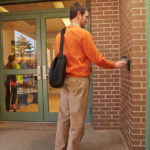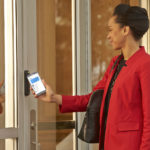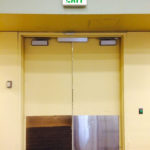 For years, I have been struggling with a common code interpretation related to electrified hardware, and I know that some of you have too. I have spent countless hours explaining that the most common type of door with an access control reader is not one of the special locking arrangements addressed by the model codes. With the release of the 2021 IBC Commentary, this just got a lot easier (you can purchase the Commentary here).
For years, I have been struggling with a common code interpretation related to electrified hardware, and I know that some of you have too. I have spent countless hours explaining that the most common type of door with an access control reader is not one of the special locking arrangements addressed by the model codes. With the release of the 2021 IBC Commentary, this just got a lot easier (you can purchase the Commentary here).
Let me back up and give you an example. The main entrance door of a high school has electric latch retraction panic hardware, and the latch can be retracted by a credential reader on the exterior, or by school personnel in the main office. School staff can present a valid credential to the reader to gain access. When a visitor arrives, they use the intercom to contact the office, and the latch is retracted by a remote switch to allow the visitor to enter the building.
This electrified hardware hardware does not affect egress in any way. To exit at any time, a building occupant can push the touchpad of the panic hardware to unlatch the door – just as they would if the panic hardware was not electrified. The vast majority of doors with electrified hardware operate this way – the access control system controls ACCESS, but does not affect EGRESS. Of course, there are some doors where the electrified hardware does have an effect on egress, and those are the special locking arrangements (ex: delayed egress locks, controlled egress in health care, sensor release locks, etc.).
When the electrified hardware allows free egress, it is not a special locking arrangement – it is a “normal locking arrangement.” In the past and current model codes, there has been no section that specifically addressed electrified hardware that allows free egress. These normal locking arrangements must comply with the same requirements that apply to mechanical hardware:
- The door must unlatch with one releasing motion for egress (with some exceptions).
- Egress must require no key, tool, special knowledge or effort.
- Operation of the door hardware must require no tight grasping, pinching, or twisting of the wrist.
- Operable force for the hardware must be within the limits of the applicable code or standard.
- Releasing hardware must be mounted between 34-48 inches above the floor (with some exceptions).
Some code officials – after understanding how this electrified hardware operates – agree that these are not special locking arrangements. Other code officials try to apply one of the special locking arrangements sections to these doors, even though the hardware allows free egress at all times. It has been difficult to clear this up without a code section addressing normal locking arrangements.
In the 2024 I-Codes, there will be a specific section to reference for doors that have access control hardware that allows free egress. In the meantime, the 2021 IBC Commentary includes some language that can help to clarify the intent of the code. Although the Commentary is not part of the enforceable code, many code officials and others rely on this supplemental information.
Regarding Section 1010.2, Door Operations, the 2021 IBC Commentary states:
Egress doors are permitted to be locked to prevent entry, but must be capable of being unlocked and readily openable from the side from which egress is to be made. The outside of a door (the access side of the door) can be locked and unlocked with a key or electronic credential such as a card, fob, or code as long as the inside—the side from which egress is to be made—can be unlocked without the use of tools, keys or special knowledge or effort. For example, an unlocking operation that is integral with an unlatching operation is acceptable.
A common question: if a door has an access control system (such as a card reader and electrical locking hardware affecting ingress into a space) what does the code require for an access control system on the ingress side of the door? While some egress doors with electrified hardware are required to comply with the sections of this code that address special locking arrangements (Sections 1010.2.11, 1010.2.12, 1010.2.13, 1010.2.14 and 1010.2.15), the most common application for electrified hardware is one where an access control reader on the ingress side of the door controls access, and the door hardware on the egress side allows free egress at all times. A door with this most common configuration of electrified hardware is subject to the same requirements as a door with a mechanical lock controlling ingress (such as a lock operated by a key on the outside): the door must allow free and immediate egress with one releasing motion to unlatch the door, without the use of a key, special knowledge or effort, and with no tight grasping, tight pinching, or twisting of the wrist.
I think this Commentary language will go a long way toward helping with these interpretations, until this is clarified in the 2024 I-Codes. I will work on a code summary on this topic, similar to the one for temperature rise doors. If there is anything you’d like me to address in the summary, leave a comment.
You need to login or register to bookmark/favorite this content.









Hey Lori,
Have you had any luck with convincing a plan reviewer/AHJ that these doors aren’t special locking arrangements and how did you do so? We have had this issue lately and the AHJ doesn’t recognize the commentary language of the 2018 IBC. By their reading, any door with a card reader now must comply with one of the “electrically locked egress doors” even if the door is only locked for INGRESS with tradition latch/strike locking methods (not a maglock). Basically, they still see the card reader/electronic function as being on the egress door therefore it needs to be tied to fire alarm and release upon alarm or loss of power. This is true even for sensitive spaces within a hospital that would otherwise not need to unlock. The explanation that if this door acts exactly as one with a normal keyed lock would – just that it has an “electronic key” doesn’t make any headway either. Really stumped on how get past a fundamental misunderstanding like this.
Hi Aaron –
We (BHMA Codes and Government Affairs Committee) have been working on this for several years because this is a common misinterpretation of the model codes. The 2024 edition of the IBC will have a specific section of the code that addresses doors with access control hardware that prevents access but does not affect egress. I have added some links below to articles that might help. If you can think of anything else I can create or find for you, let me know.
This article addresses the electrified hardware changes coming in the 2024 IBC (NFPA 101 is still in progress): https://idighardware.com/2022/01/whats-next-2024-ibc-changes-electrified-hardware/.
This article talks about special locking arrangements vs. normal locking arrangements: https://idighardware.com/2021/08/decoded-special-locking-arrangements-vs-normal-locking-arrangements/.
Here is a post about the IBC change, including a link to a video where the issue was discussed by the ICC Technical Committee. The post also includes the modified section: https://idighardware.com/2021/08/ibc-e49-21-normal-locking-arrangements/.
– Lori
Thanks Lori,
I wonder if the other missing thing in the code would be having some of the definitions for these terms. I find that the misinterpretation stems from what these terms are. I think that would help those in states where we are quite a few versions behind. At this rate, we likely won’t be using 2024 until 2028 – almost 6 years away!
Items that could potentially use some definitions:
Controlled Egress, Access Control, Delayed Egress, Egress Doors (that this only applies in the egress direction not ingress), Electromagnetically locked.
Thanks Aaron –
I would consider this change more of a clarification of the intent of the code than an actual change, so I don’t think you need to wait until it’s adopted locally to start using it to help with more consistent interpretations. I have written a few different articles to try to help differentiate between special locking arrangements and normal locking arrangements, so those might be helpful. I’ll add your suggestion about definitions to my wish list for the 2027 model codes.
– Lori